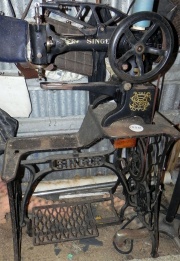Singer Manufacturing Co

of 42-5 St. Pauls Churchyard, London (1908)
of Kilbowie Road, Clydebank (1961)
1856 Singer Manufacturing Co of New Jersey opened a branch office in Scotland.
1867 Singer's first factory outside the U.S.A. was opened in Glasgow, Scotland. Singer decided that the demand for their sewing machines in the UK was sufficiently high to open a local factory in John Street. Glasgow was selected for its iron making industries, cheap labour and possibly because at the time the General Manager of the Singer Manufacturing Co of New Jersey was George McKenzie, who was of Scottish descent.[1]
1870 Sales and Distribution centers were opened in England. The Singer Red "S" girl trademark was introduced and becomes a well known trademark throughout the world.
1871 The Bridgton factory becomes the largest in Britain.
1875 Isaac Merritt Singer died in Torquay, England at the age of 63.
1883 The largest sewing machine factory in the world was opened at Kilbowie in Scotland. At one point, this factory employed over 12,000 workers.
1891 First use of an electric motor to power a commercial sewing machine.
1904 Singer Sewing Machine Co became the sales and distribution division of Singer Manufacturing Company.
1904 Singer Manufacturing Co held the Royal Warrant[2]
1905 Singer Manufacturing Co was formed as a private company in Britain. The company was registered on 29 April, to acquire business as regards the United Kingdom of sewing machine manufacturers from the Singer Manufacturing Co of New Jersey. [3]
Demand continued to exceed production, so each building was extended upwards to 6 storeys high.[4]
In 1913 the factory shipped 1.3 million machines.[5]
1917 Company made public.
1961 Manufacturers of sewing machines, cabinets and motors. 15,101 employees. [6]
Between 1961 and 1964 the Clydebank factory underwent a £4 million modernization programme which saw the Clydebank factory cease the production of cast iron machines and focus on the production of aluminium machines for western markets.
1963 As part of the modernisation programme the famous Singer Clock was demolished.
At the height of its productiveness in the mid 1960s Singer employed over 16,000 workers but by the end of that decade compulsory redundancies were taking place and 10 years later the workforce was down to 5,000.
Financial problems and lack of orders forced the world’s largest sewing machine factory to close in June 1980.
The complex of buildings was demolished in 1998.




























